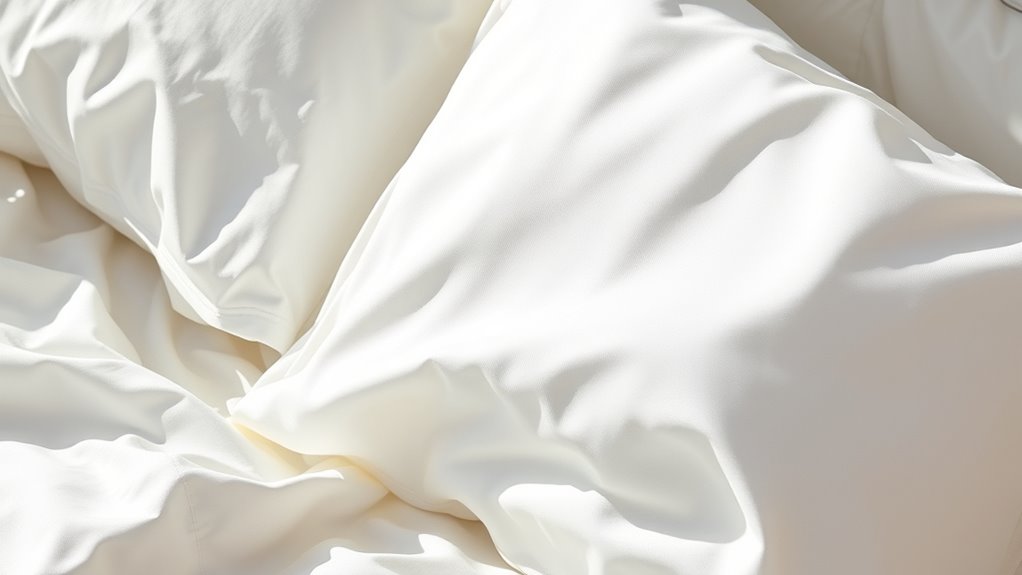Breathable bedding materials like linen and bamboo help improve airflow and comfort by actively managing moisture and temperature while you sleep. They draw sweat away from your skin, wick moisture to the surface, and promote airflow to regulate your body heat. These fabrics prevent stuffiness and keep you feeling cool or warm as needed, ensuring restful sleep. If you want to discover more about how these materials work, keep exploring the options that enhance your sleep environment.
Key Takeaways
- Natural fabrics like linen and bamboo excel at promoting airflow and moisture-wicking properties for enhanced breathability.
- Loosely woven, lightweight textiles facilitate heat dissipation and allow quick evaporation of sweat.
- Breathable bedding materials actively draw moisture away from the skin, preventing clammy or uncomfortable feelings.
- Properly constructed breathable fabrics support temperature regulation, preventing overheating or chills during sleep.
- Easy-care materials maintain their airflow and moisture management features wash after wash, ensuring long-lasting comfort.

If you’ve ever woken up feeling sweaty or uncomfortable, breathable bedding could be the solution. When your sheets trap heat and moisture, it disrupts your sleep and leaves you feeling restless. That’s where bedding made from moisture wicking fabrics comes into play. These materials are designed to draw sweat away from your skin, helping you stay dry and comfortable throughout the night. Instead of absorbing moisture like traditional cotton, moisture wicking fabrics actively move it to the surface, where it can evaporate quickly. This process not only keeps you dry but also prevents that clammy feeling that can ruin a good night’s sleep.
Breathable, moisture-wicking bedding keeps you dry and comfortable all night long.
Temperature regulation is a key benefit of breathable bedding. When you sleep, your body naturally fluctuates in temperature, and having bedding that adapts to those changes makes a significant difference. Breathable materials promote airflow, allowing heat to escape and cool air to circulate around your body. This helps keep your body at an ideal sleeping temperature, preventing overheating or chills. For example, fabrics like linen or bamboo are naturally breathable and excel at temperature regulation. They’re lightweight and have a loose weave, which allows air to flow freely and helps dissipate heat, so you don’t wake up feeling too hot or too cold.
Choosing the right bedding made from breathable fabrics also means you’re less likely to wake up sweaty or clammy in the middle of the night. When your bedding helps manage moisture and temperature, you’re less prone to tossing and turning, which leads to more restful sleep. You’ll notice that you wake up feeling more refreshed and less groggy. Additionally, these fabrics tend to be more durable and easier to care for, maintaining their breathability wash after wash. Proper fabric construction enhances their airflow and moisture management properties, ensuring long-lasting comfort.
Incorporating moisture wicking fabrics into your bedding isn’t just about comfort; it’s about creating a healthier sleep environment. Excess moisture can lead to mold or bacteria buildup, which can cause skin irritations or allergies. Breathable bedding minimizes this risk by allowing moisture to escape, keeping your sleeping area cleaner and more hygienic. So, when you make the switch to bedding made from moisture wicking fabrics and materials that promote temperature regulation, you’re investing in better sleep quality and overall well-being. It’s a simple change that can make a noticeable difference in how you rest each night.
Frequently Asked Questions
How Do I Choose the Best Breathable Bedding for Hot Sleepers?
To choose the best breathable bedding for hot sleepers, focus on materials that promote temperature regulation and moisture wicking. Look for natural fibers like cotton or bamboo, which allow air to flow and keep you cool. Avoid synthetic fabrics that trap heat. Opt for lightweight, breathable sheets with good moisture-wicking properties to stay dry and comfortable all night long. This way, you’ll enjoy a cooler, more restful sleep.
Are There Allergy-Friendly Breathable Bedding Options Available?
Like a shield protecting you from allergens, allergy-friendly breathable bedding options are available. You can choose hypoallergenic fabrics such as organic cotton, bamboo, or Tencel, which naturally resist allergens. Look for bedding treated with allergy-friendly treatments that prevent dust mites and mold growth. These options keep air flowing and skin breathing, ensuring you sleep comfortably while minimizing allergy triggers. Your restful sleep is just a choice away.
Can Breathable Bedding Help Reduce Night Sweats Effectively?
Yes, breathable bedding can help reduce night sweats effectively. It improves moisture regulation, pulling excess sweat away from your skin, which keeps you dry and comfortable. Additionally, breathable materials help maintain a stable sleep temperature, preventing you from overheating. By choosing bedding that promotes airflow and moisture control, you can enjoy more restful sleep and wake up feeling refreshed, free from the discomfort of night sweats.
How Should I Care for and Wash Breathable Bedding Materials?
To keep your breathable bedding in top shape, follow care instructions carefully. Wash your bedding on a gentle cycle with mild detergent and cold water to preserve its breathable qualities. Avoid fabric softeners and bleach, which can damage the material. Dry it on low heat or air dry to prevent shrinking. These washing tips help maintain airflow, comfort, and longevity of your breathable bedding.
Do Breathable Fabrics Require Special Maintenance Compared to Standard Bedding?
Breathable fabrics do require some special fabric care and washing tips, but they’re generally easy to maintain. You should wash them in cold or warm water on a gentle cycle to preserve airflow features. Avoid bleach and fabric softeners, which can damage the fibers. Dry on low heat or air-dry to prevent shrinking. Following these washing tips helps keep your breathable bedding comfortable and durable over time.
Conclusion
Choosing breathable bedding naturally enhances your sleep quality, helping you stay cool and comfortable all night. It’s funny how the right materials can make such a difference, almost like they were made just for you. When you prioritize airflow and comfort, you might find yourself waking up refreshed, wondering how you ever slept without it. Sometimes, the best sleep solutions are the ones you stumble upon—like breathable bedding—making every night a little more restful than the last.









